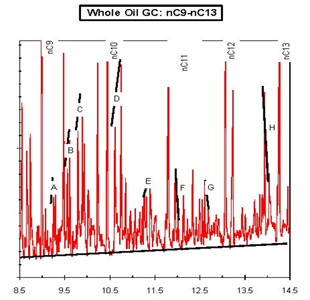Reservoir geochemistry is becoming more and more important to understanding the distribution of liquid hydrocarbons within a reservoir and its compartments (if any).
[A] Reservoir Definition
The main objectives would be:
Identification and delineation of producing intervals in sandstones or carbonate reservoirs
Identification and delineation of producing intervals in fractured source rock reservoirs
Identification of hydrocarbon types
Definition of gas-oil and oil-water contacts
Definition of oil quality and producibility
Organic source type, thermal maturity, and type and degree of alteration
Samples to be utilised would include:
Sidewall cores
Conventional core
Drill cuttings (preserved)
[B] Reservoir Continuity and Related Problems
The main objectives would be:
Define vertical and lateral reservoir continuity and understand reservoir compartmentalization in oil fields
Production allocation in commingled or multizone production
Detection of leakage in commingled production
Detection of drilling fluid contamination
Reservoir filling history
Samples to be utilised would include:
Crude oils and condensates
A typical Analytical Package:
Standard Analysis
Whole oil GC for reservoir oil fingerprinting (provides light hydrocarbon GC data, C15+ GC data)
Measurement of smaller naphthenic and aromatic peak pairs (provides the data for the ratio calculations used in the starplots and dendograms)
Optional Analysis
Quantitative saturate fraction GC-MS
Quantitative aromatic fraction GC-MS
Stable carbon isotope ratios
Interpretation
A detailed interpretation can be provided to assess the degree of similarity between liquid hydrocarbons from separate units within the reservoir. Conclusions drawn will aid in evaluation of potential compartmentalisation of the host reservoir.
[A] Reservoir Definition
The main objectives would be:
Identification and delineation of producing intervals in sandstones or carbonate reservoirs
Identification and delineation of producing intervals in fractured source rock reservoirs
Identification of hydrocarbon types
Definition of gas-oil and oil-water contacts
Definition of oil quality and producibility
Organic source type, thermal maturity, and type and degree of alteration
Samples to be utilised would include:
Sidewall cores
Conventional core
Drill cuttings (preserved)
[B] Reservoir Continuity and Related Problems
The main objectives would be:
Define vertical and lateral reservoir continuity and understand reservoir compartmentalization in oil fields
Production allocation in commingled or multizone production
Detection of leakage in commingled production
Detection of drilling fluid contamination
Reservoir filling history
Samples to be utilised would include:
Crude oils and condensates
A typical Analytical Package:
Standard Analysis
Whole oil GC for reservoir oil fingerprinting (provides light hydrocarbon GC data, C15+ GC data)
Measurement of smaller naphthenic and aromatic peak pairs (provides the data for the ratio calculations used in the starplots and dendograms)
Optional Analysis
Quantitative saturate fraction GC-MS
Quantitative aromatic fraction GC-MS
Stable carbon isotope ratios
Interpretation
A detailed interpretation can be provided to assess the degree of similarity between liquid hydrocarbons from separate units within the reservoir. Conclusions drawn will aid in evaluation of potential compartmentalisation of the host reservoir.


